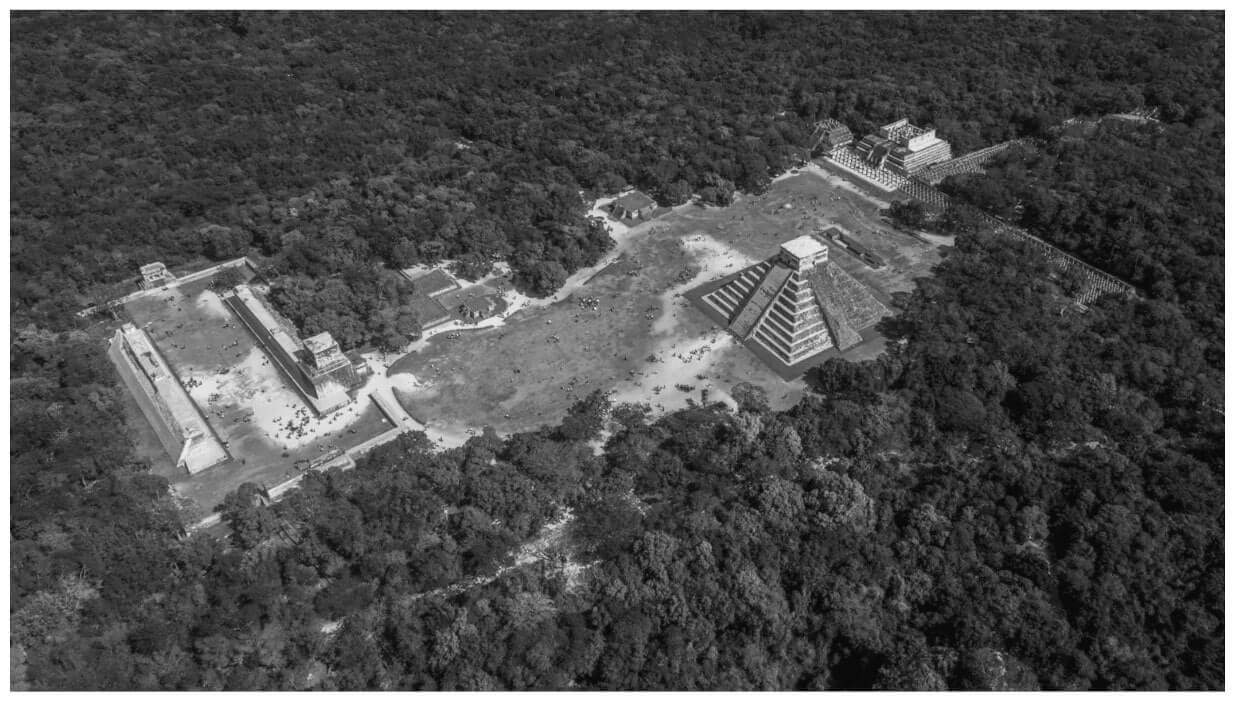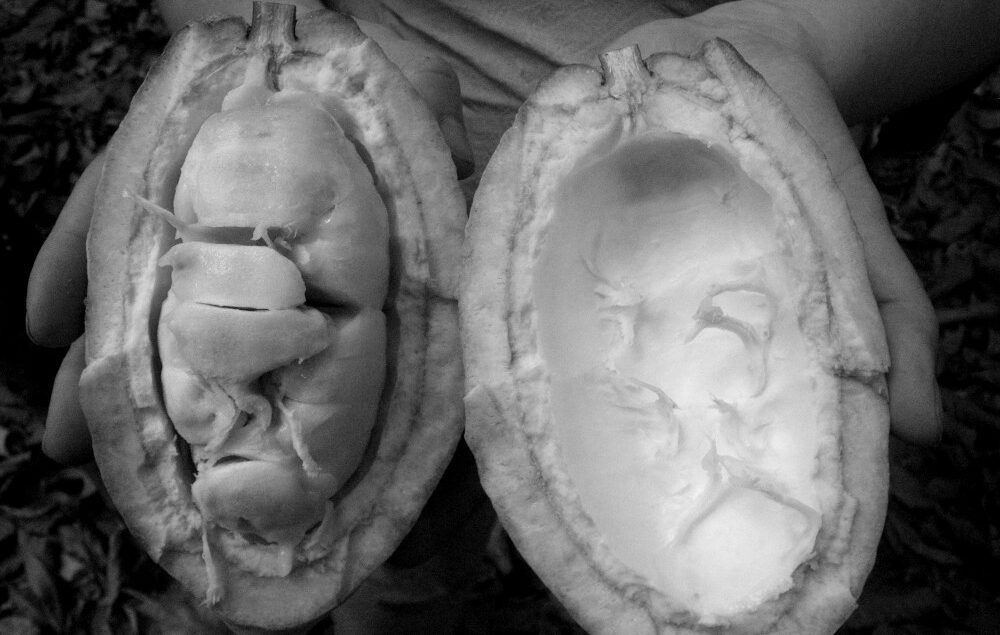Discover cacao in Chichen Itza, the most important archaeological vestige of the Maya-Toltec civilization in Yucatan, Mexico. I am a historian and visiting archeological sites for me is like time travel, an enriching and fascinating journey into the past.
In this Article
Chichen Itza
The Quiché/K’iche Mayan city is home to numerous stepped pyramids, columned arcades, and temples. Chichen Itza also has a variety of other structures densely packed in the ceremonial center of about 5 square kilometers (1.9 sq mi) and several outlying subsidiary sites.
Central are, the Temple of the Warriors, “Templo de los Guerreros” (with impressive One Thousand entrance Columns), the “Muro de los Craneos” and “El Caracol”, an astronomical observatory. One of the most unexpected structures is without a doubt, the ball court.
We came to learn that it is the largest known ball court of its kind in the whole of the Americas, measuring 554 feet (168 meters) long and 231 feet (70 meters) wide. Everyone came to watch the games including the Mayan royals who sat on either end of the court.
During this ritual games, ball players tried to hit a 12-pound (5.4-kilogram) rubber ball through stone scoring hoops set high on the court walls. Competition must have been fierce indeed – players were put to death.

Viewed as a whole, the incredible complex reveals much about the Quiché/K’iche Maya and Toltec vision of the universe – which was intimately tied to what was visible in the dark night skies of the Yucatan Peninsula. As I claimed up the steps, it was allowed back in the days, of the great Pyramid, also known as El Castillo, I am reminded of what our guide told us:
The snake on El Castillo
According to legend, Kukulcán, the feathered serpent god, alights from the heavens, blesses his worshipers on earth, and then makes his way to the underworld, or Xibalba. In reality, the setting sun during the spring and fall equinoxes casts a shadow on the northern balustrade of El Castillo that resembles the form of a snake slithering down the stairs, an effect which is heightened by the heads of sculpted beasts at the base.
Every equinox, an enormous snake born from the shadows slithers down the side of the Temple of Kukulcan.
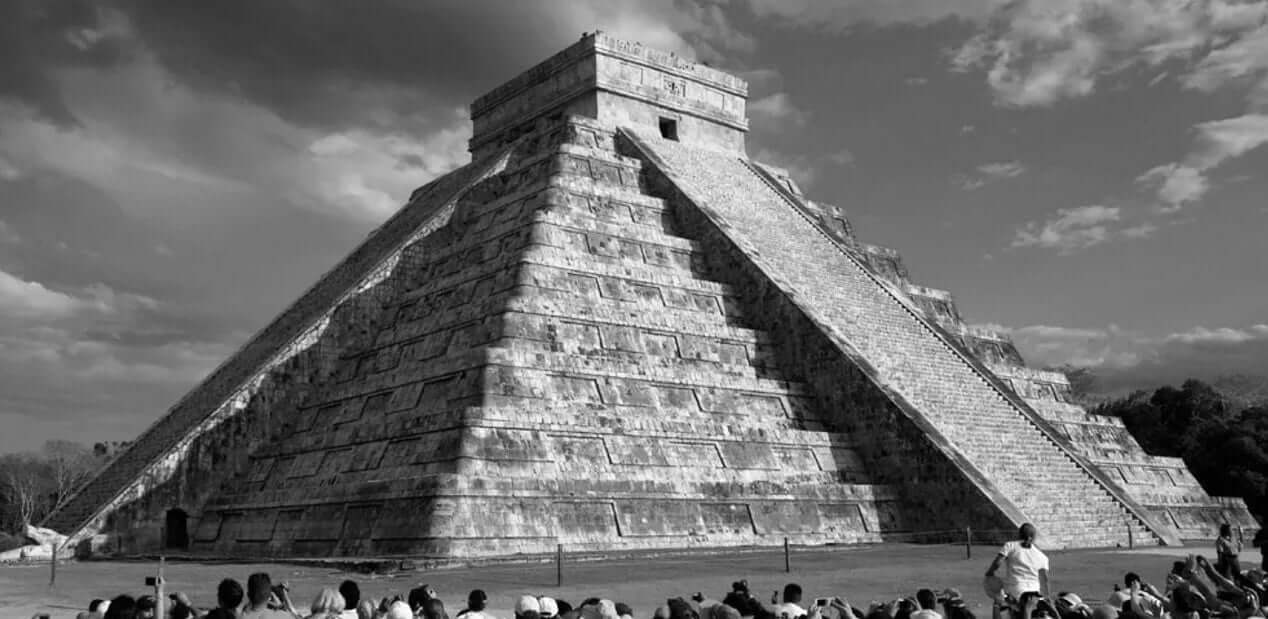
As our guide would clap his hands at the base of the stairs, an echo ringed through the air. It wasn’t an ordinary booming echo, either. It sounds like the song of a ghostly flock of birds, a chorus of chirps that crescendos before fading into silence.
During ceremonies when Kukulcan was being called upon or worshiped, a priest would face the pyramid and clap, creating this chirp. He’d then turn and face the Temple of Warriors and clap again, causing a low rattle to seemingly emit from the rocks. The chirp and rasping whisper of an echo were believed to be the voice of the god.
The birdsong may be no coincidence. According to some acoustic scholars, it mirrors the call of the resplendent quetzal, a gorgeous bird cloaked in an opulent array of green and red feathers. Like the snake, the quetzal was considered divine by the Quiché/K’iche Maya.
This “god of the air” was a symbol of goodness and light. Its tail feathers adorned the headdresses of many a noble (no birds died during the creation of the headdresses, as killing a sacred quetzal was forbidden).
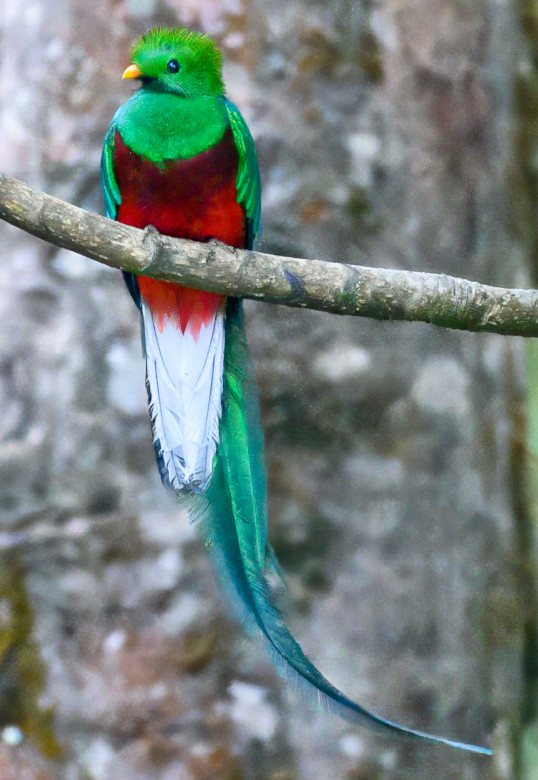

Chichen Itza was a Quiché/K’iche Mayan city on the Yucatan Peninsula in Mexico and named a UNESCO World Heritage Site in 1988. Flourishing from the ninth to the thirteenth century CE, the city was an important religious and ceremonial site, as well as a sophisticated urban center and hub of regional trade:
The monuments of Chichen-Itza, particularly in the northern group, which includes the Great Ball Court, the Temple of Kukulkan and the Temple of the Warriors, are among the undisputed masterpieces of Mesoamerican architecture because of the beauty of their proportions, the refinement of their construction and the splendor of their sculpted decorations.
The monuments of Chichen-Itza exerted an influence throughout the entire Yucatan cultural zone and the most important archaeological vestige of the Maya-Toltec civilization in Yucatan (10th-15th centuries).
After centuries of prosperity and absorbing influxes of other cultures like the Toltecs, the city met a mysterious end. Scientists speculate that droughts, exhausted soils, civil war and royal quests for conquest and treasure may have contributed to Chichén Itzá’s downfall.
Today, Chichen Itza still remains an active archeological site. New discoveries are being unearthed in the area, providing even more insight into the culture and accomplishments of the Quiché/K’iche Mayan people, who ruled much of present-day Mexico and Central America prior to the arrival of European colonists.
Cenote
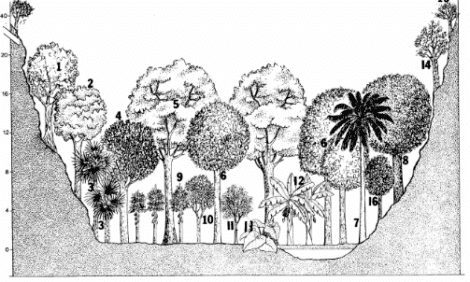
During the Classic period the town of Chichen-Itza was established close to two natural cavities (cenotes or chenes), which gave the town its name “At the edge of the well of the Itzaes”.
The cenotes facilitated tapping the underground waters of the area. The dates for this settlement vary according to subsequent local accounts: one manuscript gives 415-35 CE, while others mention 455 CE.
Production of cacao in Yucatan
As for the possibilities of raising cacao trees in Yucatán, there are major natural obstacles. Firstly, the rainfall in this region is relatively scanty, and gets progressively more so as one moves to the northwestern part of the peninsula.
Secondly, being a limestone karst plain, there are virtually no rivers, and the rich alluvial soils favorable to cacao growth are absent. Only in the lands bordering Chetumal Bay in the southeast, and along the Belize River to the south, were commercially viable cacao plantations possible.
Yet cacao had so much religious and social prestige among the Yucatec Maya that they found a means to grow it anyway. This was through the exploitation of humid, soil-filled sinkholes, known locally as cenotes (corrupted from the Mayan dzonot).
Early Spanish sources on 16th-century Yucatán, such as Fray Antonio de Ciudad Real and the famous (and infamous) Bishop Landa, mention mini-plantations, Landa even describing them as “sacred groves.”
– In fact, they gave “very little fruit.”
Recently, Arturo Gómez-Pompa and his colleagues have found cacao trees, along with other species, growing in just such sinkholes near the town of Valladolid, Yucatán, in which the damp micro-environment and rich soils provide an ideal setting for this plant in the otherwise dry peninsula.
Cacao in Chichen Itza – The Temple of the Owls

The painted capstone from the Temple of the Owls in Chichén Itzá
Old Chichen (Spanish Chichén Viejo) is the name given to a group of structures to the south of the central site, where most of the Puuc-style architecture of the city is concentrated. It includes the Initial Series Group, the Phallic Temple, the Platform of the Great Turtle, the Temple of the Monkeys, and the Temple of the Owls.
A painted capstone from the Temple of the Owls in Chichén Itzá, depicts the spiritual significance of cacao and the cenote.
God K’awiil and Cacao or K’awiil’s flight from the Underworld
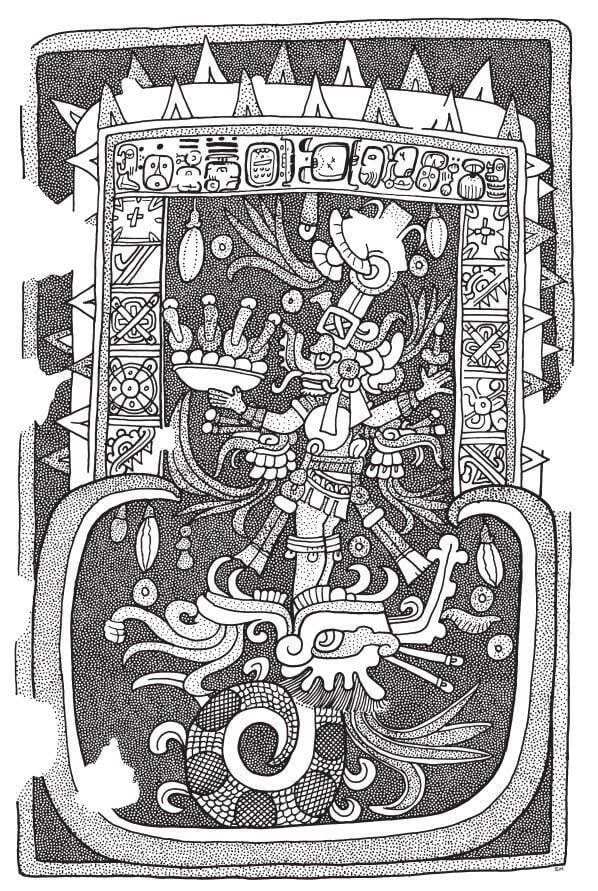
This vividly painted panel within the structure depicts the Quiché/K’iche Maya god K’awiil emerging from a serpent holding a plate with offerings possibly containing cacao, and jade ear spools. Taube states: rather than representing jade, these elements refer to another precious substance, the flower of the cacao. An incomplete date is mentioned in the glyphic text. Sky bands frame the sides of the panel.
The Quiché/K’iche Maya God K’awiil, is the lord of sustenance and of royal descent, his presence, given his connection to royal descent, points to the association between the cacao and cenote and the noble and powerful lineages, supporting the notion that the cenotes were a symbol of wealth and power.
In the capstone, as Simon Martin describes, K’awiil emerges from the underworld, which is depicted as a cenote, in pursuit of the heavens above:
Cacao pods hang as if naturally growing from both the heavens and the underworld. The god’s expression of “rescuing” the seeds from the cenote and their “gifting to heaven and earth” in this scene depict the significance of the spiritual value of cacao.
Beyond being a status symbol, cultivation of cacao in cenotes also indicates the spiritual importance of cacao. Having the origins of cacao not on Earth but in the Underworld which then was taken to heaven and earth.
Cross culturally, trees supply a rich collection of metaphorical meanings appropriate to generational descent, and in Maya ideology they evidently constitute a bridge between death and rebirth. It is the Maize God’s manifestation as a fruit tree that allows him to pass on his procreative seed and to eventually triumph through the heroic deeds of his offspring.
God L and Cacao
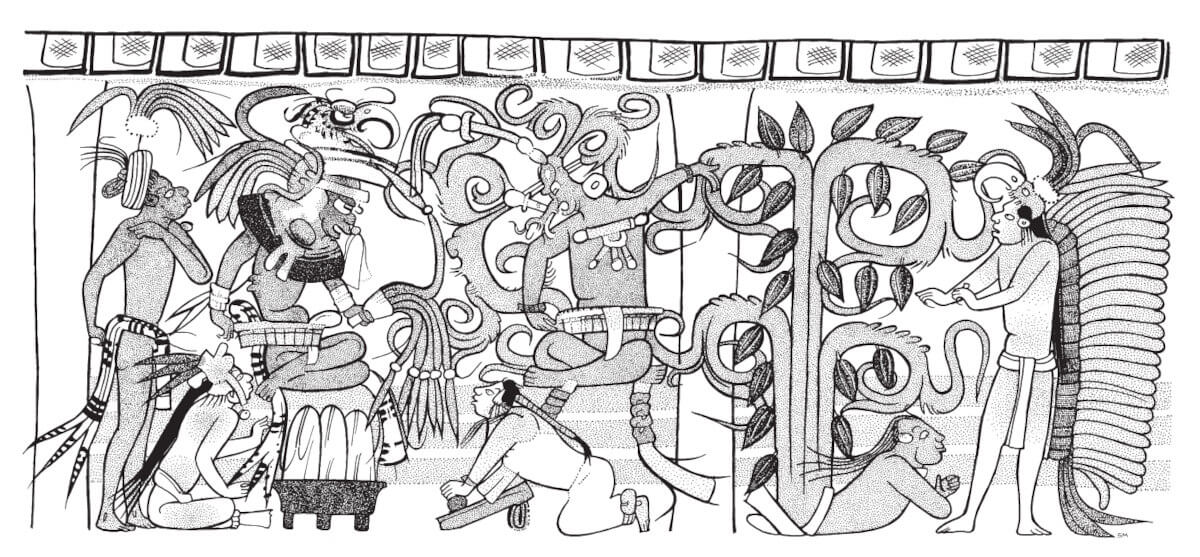
There is a direct connection between the images at Temple of Owls and vessel K631, both showing cacao as a sacred tree which is related to the Underworld and God L and taken to earth for the sustenance of humankind.
God L is related with cacao wealth as well as having ties to commerce and long-distance trade (depicted in murals at Cacaxtla, Mexico and narrative in the Popol Vuh)
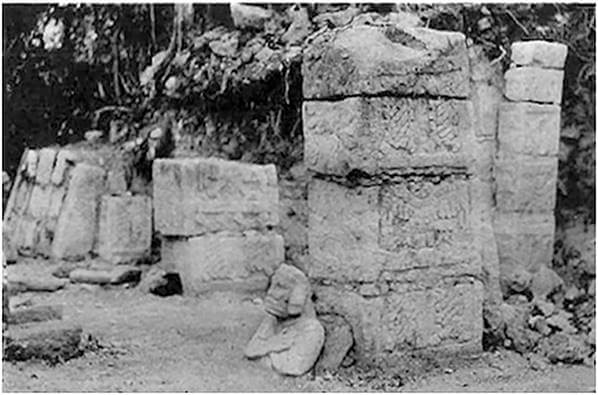
The iconography of the Temple of the Owls largely replicates that on K631 and should encode the same narrative thread. The fruiting iximte’ maize/cacao tree, places the temple in a symbolic Underworld, while the emblematic owls invite thoughts of God L’s owls. In combination with the “royal” mat symbols, these features suggest we are looking at a physical reproduction of the same palace pictured on K631. The location of the capstone image is far from incidental, so Simon Martin.
The two piers that once supported the wide central doorway of the temple sanctuary carry relief carving on each of their four faces. Three show alternating panels of mat symbols and the horned owls that give the building its name.
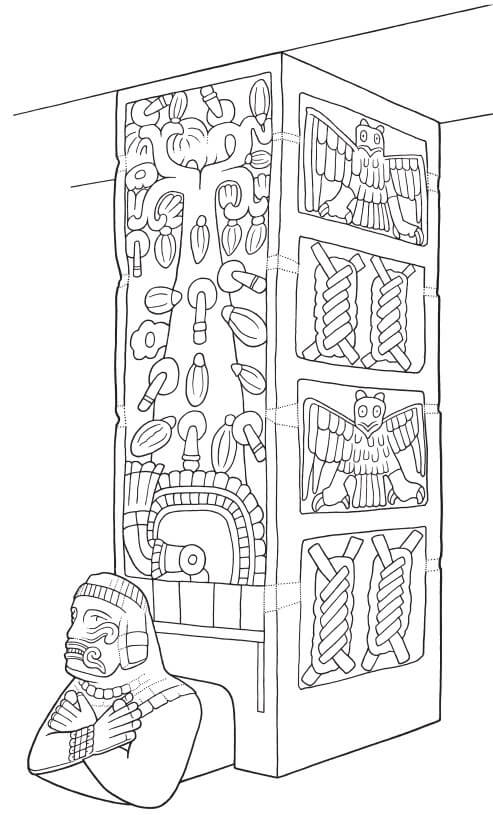
But the remaining, outward facing side shows a trunk weighted with cacao pods and motifs that resemble both long-pistiled flowers and jade ears pools. The same objects appear in K’awiil’s bowl on the capstone. (K’awiil’s flight from the Underworld.)
At the foot of this tree is a beaded semicircular motif, most likely another flower-jewel. Beneath this is an open socket into which is set a three-dimensional sculpture of a humanoid in a crossed-arm pose, creating a match for the anthropomorphic cacao tree on K631.

The second pillar shows also a trunk weighted with cacao pods and motifs that resemble both long-pistiled flowers and jade ears pools:
The temple is a one-story structure located in the center of the Southwest Plaza in Chichen Itza. The collapsed building was completely reconstructed between 1999-2002.
A now destroyed painted capstone within the structure has given it a tentative date of c.870 BC An interior sanctuary contains a single bench. The upper portions of the interior walls once contained vivid murals now destroyed.
A large owl figure consisting of five blocks was discovered and restored from within the structure. The upper facade features ten owl decorations interspersed between human/bird figures. The facade is bordered by two rows of turtles. At the corners are Chaac masks. Over the entryway is a figural decoration, and representations of cacao pods.
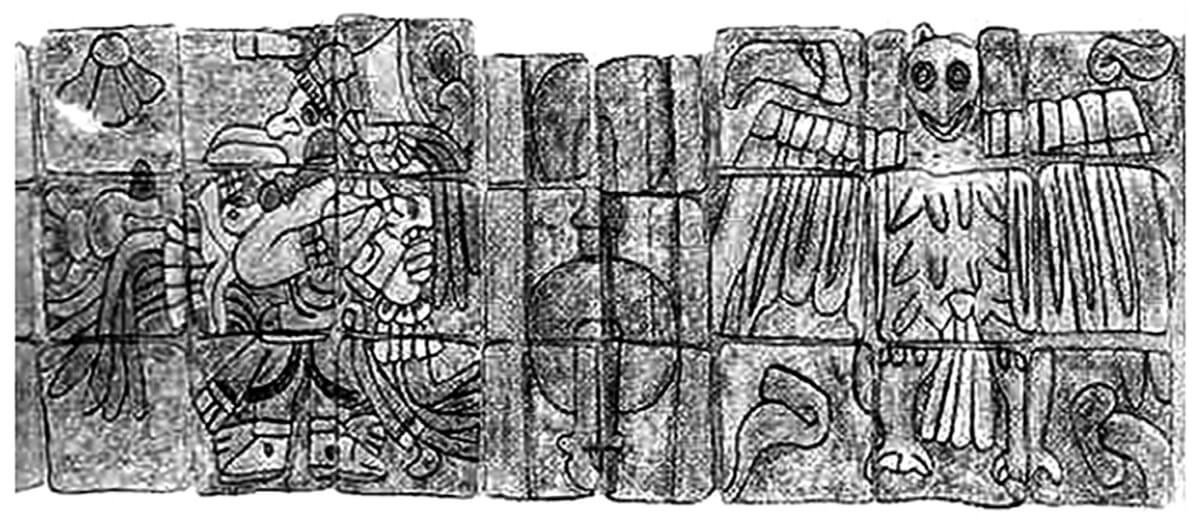
The Temple of the Owls appears to be a shrine celebrating the maize-cacao tree and the setting for appropriate rituals and reenactments by the Chichen Itza elite.
~ ○ ~
Works Cited & Multimedia Sources
- A concise history of chocolate. https://www.c-spot.com/atlas/historical-timeline/
- Anonymous, The Vertues of Chocolate East-India Drink, one page. This apparently was taken out of Antonio Colmenero, Chocolate: Or, An Indian Drink, translated into English by James Wadsworth.
- Christenson, Alan. Popol Vuh: The Sacred Book of the Maya. 2003.
- Clarence-Smith William Gervase. Cocoa and Chocolate. 1765–1914. 2000.
- Coe, Sophie D., Michael D. Coe, and Ryan J. Huxtable. The true history of chocolate.1996. Thank you.
- Colmenero de Ledesma, A Curious tretise on the nature and quality of chocolate. Trans. Don Diego Vades-forte [James Wadsworth].1640.
- Colmenero de Ledesma. Curioso Tratado de la naturaleza y calidad del chocolate. Madrid, 1631. (Latin 1644)
- Fao infographik http://www.fao.org/resources/infographics/infographics-details/en/c/277756/
- Girard, Rafael.Esotericism of the Popol Vuh: The Sacred History of the Quiché Maya. Theosophical UniversityPress, Pasadena. 1979.
- Grivetti Louis E., Shapiro Howard-Yana. Chocolate – History, Culture, Heritage.
- Grivetti Louis Evan & Shapiro Howard-Yana. Chocolate: History, Culture and Heritage. 2009. [NOTE: this book offers extensive descriptions and translated excerpts from primary documents describing Early New Spain chocolate recipes.]
- Grofe Michael J. The Recipe for Rebirth: Cacao as Fish in the Mythology and Symbolism of the Ancient Maya.
- Grofe Michael J. The Recipe for Rebirth: Cacao as Fish in the Mythology and Symbolism of the Ancient Maya. 2007. Thank you.
- https://foodtimeline.org/foodmaya.html#hotchocolate
- https://www.mexicolore.co.uk/maya/chocolate/history-and-uses-of-cacao.
- Kaufman Terrence. Justeson John. The History of the word for cacao in ancient Mesoamerica. 2008. https://www.cambridge.org/core/journals/ancient-mesoamerica/article/history-of-the-word-for-cacao-in-ancient-mesoamerica/FE4A2AE4F9D0C1EDCFB583DB315907E4
- Levin Carole. How Sweet It Is: From the Mountains of Mexico to the Streets of York. Torch Magazine. 2018. http://www.ncsociology.org/torchmagazine/v913/Levin.pdf
- Martin Simon. “Cacao in Ancient Maya Religion: First Fruit from the Maize Tree and Other Tales from the Underworld,” in Chocolate in Mesoamerica: a Cultural History of Cacao, ed. Cameron L. McNeil (University Press of Florida, 2006), 179.
- Martin, Simon. “Cacao in ancient Maya religion: first fruit from the maize tree and other tales from the underworld.” Chocolate in Mesoamerica: a cultural history of cacao. 2006. Thank you.
- Maxwell Kenneth A Sexual Odyssey: From Forbidden Fruit to Cybersex. New York: Plenum.1996.
- McNeil Cameron L. Chocolate in Mesoamerica A Cultural History of Cacao. 2006.
- Moreiras, Diana K. Thinking and Drinking Chocolate: The Origins, Distribution, and Significance of Cacao in Mesoamerica. 2010.
- Pre-Hispanic City of Chichen-Itza. https://whc.unesco.org/en/list/483
- Sahagún, Bernardino de. La historia general de las cosas de Nueva España. 1552. [Nahuatl/Spanish]. Known as the Florentine Codex. The Florentine Codex: General History of the Things of New Spain. Trans. Arthur J.O. Anderson and Charles Dibble, 12 books in 13 volumes. Santa Fe: School of American Research, U of New Mexico P, and U of Utah P, 1950.
- Taube, Karl A. “The Classic Maya Maize God: A Reappraisal,” Fifth Palenque Round Table. 1983.
- Taube, Karl A. Aztec and Maya Myths: The Legendary Past. University of Texas Press. 1993.
- Tedlock, Dennis. Popol Vuh. The Definitive Edition of the Mayan Book of the Dawn of Life and the Glories of Gods and Kings. 1996 .
- The Vertues of Chocolate East-India Drink. Oxford: Henry Hall. 1660.
- Turices, Santiago Valverde. Un Discurso del chocolate. Seville, 1624.
- Young, Allen M.The Chocolate Tree: A Natural History of Cacao. Smithsonian Institution Press. 1994.
Keep exploring:
